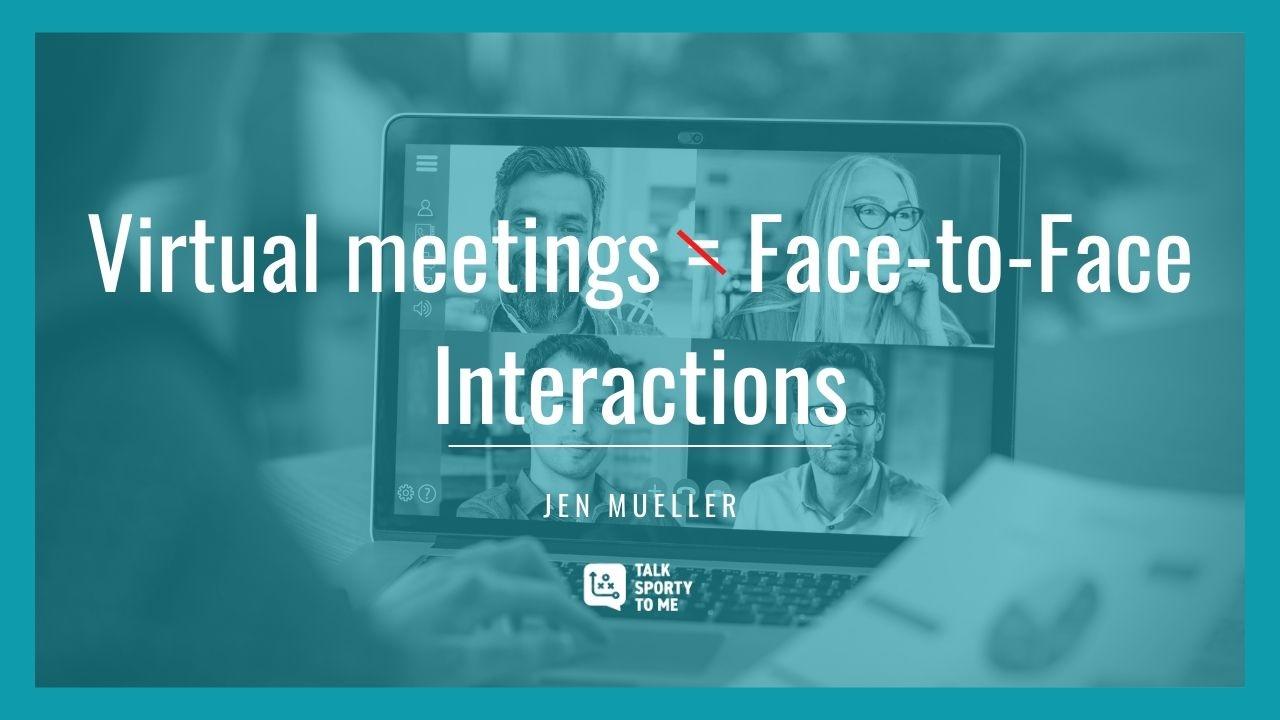Stop Comparing Virtual Meetings to Face-to-Face Interactions
May 04, 2020
Stop comparing virtual interactions to real-life, in-person conversations. They’re not the same thing.
Video conferencing, virtual happy hours and online training might be the next best thing to meeting in person, but they are not the same thing. There’s a big difference and big problem with making that assertion. Insisting video conferencing is “just like” face-to-face interactions discredits the feelings of exhaustion and fatigue that accompany virtual interactions.
If you go into the day thinking you’re going to have a conversation instead of preparing to be on camera, you’re setting yourself up for burn out, fatigue, exhaustion and frustration.
Take it from someone who’s been on camera and on TV for the last 14 years. I’m a sports broadcaster based out of Seattle. My colleagues and I can tell you from personal experience being on camera every day can be emotionally and mentally draining.
Communicating in a virtual space to a remote audience requires a different amount of energy, focus, preparation and recovery time.
5 Reasons Virtual Interactions Don’t Compare to Face-to-Face Interactions
Video is a visual medium. When you're on camera you have an audience, not a room full of people. When was the last time you thought about your lighting and background while having a face-to-face interaction with one of those people? Even on bad hair days you’re still not obsessed about finding a camera angle because you can’t see yourself during those in-person interactions.
So what? It can be exhausting to worry about what you look like on camera because you’re seeing yourself on camera. You’re thinking about it more than your audience is. You look great.
Limited eye contact. You thought making eye contact was tough? Try the alternative and see how it feels. Oh wait, that’s what you’ve been doing on all your video meetings. Eye contact is a way to connect and that doesn’t happen when you’re looking into a camera instead of at a person. In addition, that eye contact is part of body language that gets tough to read. (More on that in a couple paragraphs.)
*Reminder: If you are presenting virtually, you should be looking at the camera. It’s awkward for your audience when you don’t because the audience doesn’t know what you’re looking at and is expecting you to make eye contact with them.
So what? A lack of connection can lead to feelings of loneliness. You’re not alone.
One-sided energy. Being on camera and talking to a remote audience is like carrying on a one-sided conversation. Even if you get a reaction on your Zoom call, it won’t feel the same as being in the same room. On TV we exaggerate our energy level. There’s more emotion in our voices, our facial expressions are more dynamic. There’s a lot of smiling. Viewers at home wouldn’t guess how much more energy it takes to be on camera. It looks normal. But if my colleagues and I talked to each other on TV the way we talked to each other while eating dinner, the audience would wonder why we sounded so disinterested and flat.
So what? It’s exhausting to bring energy to both sides of a conversation without being able to feed off the energy in the room. It’s not just your imagination, virtual meetings can be exhausting.
No help from your surroundings. I bet you didn’t realize how much information you took from your surroundings until your only surrounding became your home office. It’s the smile and nod that confirms your message resonates with the audience or perhaps the subtle shift in body language that indicates they’re starting to get bored and want to wrap up a conversation.
When you have limited eye contact (see above) and reduced opportunities to read body language you also have less information about how your message lands and what other people are thinking.
So what? It’s exhausting to read an audience when you have fewer cues to read. Cut yourself some slack.
White space required. This isn’t just about taking a break and getting up from your desk. It’s about finding time where you’re not “on.” It’s important leave time in your schedule to decompress and reenergize, something you wouldn’t necessarily do on a daily basis if every conversation or meeting was in person. As a member of the media I am “on” every time I step outside my house, which is why I build time into my day to be at home, to not talk to people, and to do something other than work-related projects. Resist the urge to schedule back-to-back-to-back meetings because it’s what you’ve always done. Recognize the additional energy it takes to be on camera and give yourself white space to recover.
So what? Overall fatigue and a lack of focus is normal with the stress of the current environment, but you won’t get back to normal without giving yourself room to reenergize. Give yourself a break.
TL;DL
Virtual meetings and video conferencing can be effective, but it’s not accurate to say they’re the same as meeting face-to-face and in person. Compare virtual interactions to being on camera and you’ll be able to better avoid video fatigue and burnout.
Want more tips on communicating with remote audiences? Download the free eBook and inquire about hiring Jen for a virtual training session or customized video series for your team. Send an email to [email protected]





